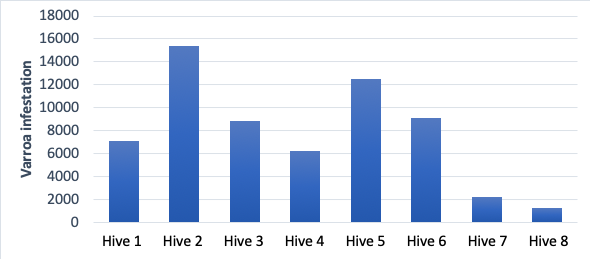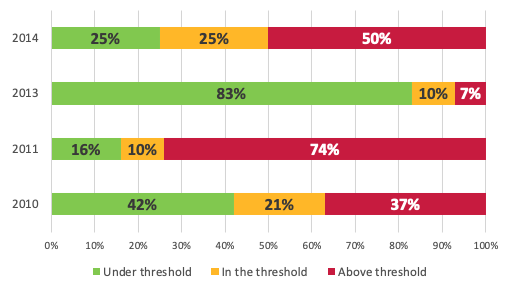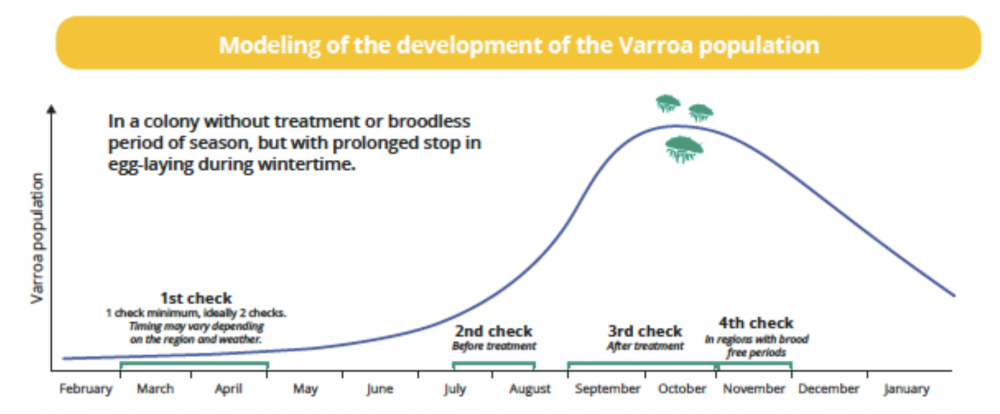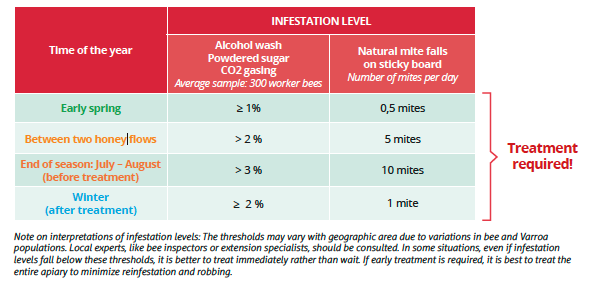 Véto-pharma
Véto-pharma As we know, Varroa infestations may be very different from one beehive to another and from one year to the next. In the same apiary, at the end of the season, you may have hives with infestations below 500 varroa mites, and others with over 15,000 mites. What can we learn from that? A varroa control strategy must be devised on a case-by-case basis and deployed right from the beginning of the season.
While it is tempting to fight infestations routinely (a single late-season treatment always at the same date), Varroa infestations can CHANGE and we should keep that in mind. Infestations may differ from one beehive to another (within the same apiary), and from one year to the next.

Figure 1 shows the infestation differences within the same apiary:
Least infested hive: 1,272 varroa mites
Highest infested hive: 15,418 varroa mites (a ratio of 1 to 12 between the minimum and the maximum infestation).
Average infestation: 7,844 varroa mites
According to Alexis Ballis, an average of 5 to 10% of the hives in a single apiary can reach infestation levels far above the apiary average.2

Figure 2 shows the Varroa infestation level in hives from the same apiary in the Alsace Region (East of France), over several years.
Green: < 3,200 varroas at the end of the season
Orange: 3,200 to 4,200 varroas at the end of the season
Red: > 4,200 varroas at the end of the season
The threshold of 3,200 to 4,200 varroas was described in the literature as a level of infestation triggering a financial loss for the beekeeper (lower production and increased mortality risk).3
When looking at Figure 2, the infestation could not be handled in the same way in 2013 and in 2014, and a set treatment during the same calendar time does not work for all beekeeping years.
It is essential to be proactive and monitor the situation early in the season to assess the infestation level and deploy – if necessary – quick reduction methods when the level exceeds the threshold. Early monitoring potentially helps control high infestation levels during, or at the end of the season, which could reduce honey production and/or jeopardize the survival of bee colonies during winter.
We often forget about environmental considerations such as climatic changes, the strain of bee, floral density and the effects of urban sprawl. In the years to follow, we may have more brood populations with infestations that will become increasingly difficult to contain and control.
Monitoring is important and the first count should be taken in March and/or April in preparation for varroa mite population benchmark and perhaps corrective action based on those results. Ideally two counts should be performed during spring, but with one you will already get the trend at the beginning of the season. The timing will depend on your location and weather conditions ; colonies’ build-up doesn’t occur on a fixed date.
At the beginning of the season, a phoretic varroa infestation greater than or equal to 1% (i.e. 3 varroa mites in a sample group of 300 adult bees) or natural falls of 1 varroa mite every two days (for the entire cluster) are considered as alert thresholds. These beehives must be managed to avoid an infestation explosion later in the season.
Timing is of the essence and will limit varroa mites’ impact on bees and their honey production. As a reminder, a study carried out on a lavender honey flow in the South of France showed that a phoretic infestation of 3% (9 varroas in a sample group of 300 bees) during the season, reduced by 5 kg on average the beehive’s honey production. The loss could reach 13 kg in some beehives. Varroas impact the health of bee colonies and their productivity.4
More counts during the season will give a better hive tracking, especially in case of “crawling” infestation early in the season.

We suggest at least 4 monitoring periods during the year:

You can go for a short treatment before installing honey supers (molecule of your choice) and/or “mechanical” (or “zootechnical”) techniques:
– Colony Division
– Removal of male brood (if any)
An early season treatment may delay the beekeeping season slightly, but it is always better to maintain healthy colonies, rather than sending them straight to honey flow and risking a decline a few months later.
Each apiary is different (geographical location, strain of bees, local weather conditions, previous treatments, etc.). Therefore, the varroa mite control strategy must be updated every year, and you are the most qualified to do it considering your beekeeper past and experience. In doubt, consult your beekeeping association, a technician/extensionist, a veterinarian… anyone who can advise you on local infestation thresholds and on the ways to reduce infestation.
References :
1. Data from the Véto-pharma apiary in 2014 in Chaillac – Total average infestation of each hive recorded after a 10-week conventional varroa mite treatment, followed by a control treatment.
2. BALLIS A. (2015) Varroa infestation in Alsace, Speech at the ADA Franche Comté General Assembly. Alsace Regional Chamber of Agriculture.
3. DELAPLANE, K S; HOOD, W M (1999) Economic threshold for Varroa jacobsoni Oud. in the south-eastern USA. Apidology 30: 383-395.
4. Maisonnasse et al, 2014 – Study carried out by INRA (France) between 2009 and 2012 on 552 beehives. Average of 5 kg (1 to 13 kg per year) on a lavender honeyflow.
Join the Véto-pharma community and receive our quarterly newsletter as well as our occasional beekeeping news. You can unsubscribe at any time if our content does not suit you, and your data will never be transferred to a third party!
© 2019-2025, Véto-pharma. All rights reserved